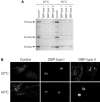Mutational spectrum of D-bifunctional protein deficiency and structure-based genotype-phenotype analysis
- PMID: 16385454
- PMCID: PMC1380208
- DOI: 10.1086/498880
Mutational spectrum of D-bifunctional protein deficiency and structure-based genotype-phenotype analysis
Abstract
D-bifunctional protein (DBP) deficiency is an autosomal recessive inborn error of peroxisomal fatty acid oxidation. The clinical presentation of DBP deficiency is usually very severe, but a few patients with a relatively mild presentation have been identified. In this article, we report the mutational spectrum of DBP deficiency on the basis of molecular analysis in 110 patients. We identified 61 different mutations by DBP cDNA analysis, 48 of which have not been reported previously. The predicted effects of the different disease-causing amino acid changes on protein structure were determined using the crystal structures of the (3R)-hydroxyacyl-coenzyme A (CoA) dehydrogenase unit of rat DBP and the 2-enoyl-CoA hydratase 2 unit and liganded sterol carrier protein 2-like unit of human DBP. The effects ranged from the replacement of catalytic amino acid residues or residues in direct contact with the substrate or cofactor to disturbances of protein folding or dimerization of the subunits. To study whether there is a genotype-phenotype correlation for DBP deficiency, these structure-based analyses were combined with extensive biochemical analyses of patient material (cultured skin fibroblasts and plasma) and available clinical information on the patients. We found that the effect of the mutations identified in patients with a relatively mild clinical and biochemical presentation was less detrimental to the protein structure than the effect of mutations identified in those with a very severe presentation. These results suggest that the amount of residual DBP activity correlates with the severity of the phenotype. From our data, we conclude that, on the basis of the predicted effect of the mutations on protein structure, a genotype-phenotype correlation exists for DBP deficiency.
Figures



References
Web Resources
-
- Online Mendelian Inheritance in Man (OMIM), http://www.ncbi.nlm.nih.gov/Omim/ (for DBP deficiency)
-
- Protein Data Bank (PDB), http://www.rcsb.org (for entries 1GZ6, 1S9C, 1IKT, and 1ZBQ)
References
-
- Adamski J, Carstensen J, Husen B, Kaufmann M, de Launoit Y, Leenders F, Markus M, Jungblut PW (1996) New 17 beta-hydroxysteroid dehydrogenases: molecular and cell biology of the type IV porcine and human enzymes. Ann N Y Acad Sci 784:124–136 - PubMed
-
- Bootsma AH, Overmars H, van Rooij A, van Lint AE, Wanders RJ, van Gennip AH, Vreken P (1999) Rapid analysis of conjugated bile acids in plasma using electrospray tandem mass spectrometry: application for selective screening of peroxisomal disorders. J Inherit Metab Dis 22:307–31010.1023/A:1005543802724 - DOI - PubMed
Publication types
MeSH terms
Substances
LinkOut - more resources
Full Text Sources
Medical
Molecular Biology Databases
Miscellaneous

